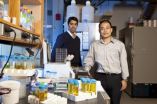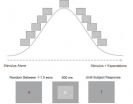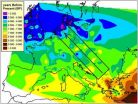(Press-News.org) A new way of splitting layered materials to give atom thin "nanosheets" has been discovered. This has led to a range of novel two-dimensional nanomaterials with chemical and electronic properties that have the potential to enable new electronic and energy storage technologies. The collaborative* international research led by the Centre for Research on Adaptive Nanostructures and Nanodevices (CRANN), Trinity College Dublin, Ireland, and the University of Oxford has been published in this week's Science.
The scientists have invented a versatile method for creating these atom thin nanosheets from a range of materials using common solvents and ultrasound, utilising devices similar to those used to clean jewellery. The new method is simple, fast, and inexpensive, and could be scaled up to work on an industrial scale.
"Of the many possible applications of these new nanosheets, perhaps the most important are as thermoelectric materials. These materials, when fabricated into devices, can generate electricity from waste heat. For example, in gas-fired power plants approximately 50% of energy produced is lost as waste heat while for coal and oil plants the figure is up to 70%. However, the development of efficient thermoelectric devices would allow some of this waste heat to be recycled cheaply and easily, something that has been beyond us, up until now," explained Professor Jonathan Coleman, Principal Investigator at CRANN and the School of Physics, Trinity College Dublin who led the research along with Dr Valeria Nicolosi in the Department of Materials at the University of Oxford.
This research can be compared to the work regarding the two-dimensional material graphene, which won the Nobel Prize in 2010. Graphene has generated significant interest because when separated into individual flakes, it has exceptional electronic and mechanical properties that are very different to those of its parent crystal, graphite. However, graphite is just one of hundreds of layered materials, some of which may enable powerful new technologies.
Coleman's work will open up over 150 similarly exotic layered materials – such as Boron Nitride, Molybdenum disulfide, and Bismuth telluride – that have the potential to be metallic, semiconducting or insulating, depending on their chemical composition and how their atoms are arranged. This new family of materials opens a whole range of new "super" materials.
For decades researchers have tried to create nanosheets from layered materials in order to unlock their unusual electronic and thermoelectric properties. However, previous methods were time consuming, laborious or of very low yield and so unsuited to most applications.
"Our new method offers low-costs, a very high yield and a very large throughput: within a couple of hours, and with just 1 mg of material, billions and billions of one-atom-thick nanosheets can be made at the same time from a wide variety of exotic layered materials," explained Dr Nicolosi, from the University of Oxford.
These new materials are also suited for use in next generation batteries – "supercapacitors" – which can deliver energy thousands of times faster than standard batteries, enabling new applications such as electric cars. Many of these new atomic layered materials are very strong and can be added to plastics to produce super-strong composites. These will be useful in a range of industries from simple structural plastics to aeronautics.
INFORMATION: END
The human body has a remarkable ability to heal itself. Due to the presence of dedicated stem cells, many organs can undergo continuous renewal. When an organ becomes damaged, stem cells in the organ are typically activated, producing new cells to regenerate the tissue. This activity of stem cells, however, has to be carefully controlled, as too much stem cell activity can cause diseases like cancer. Current research in stem cell biology is starting to unravel the control mechanisms that maintain a balance between efficient regeneration and proper control of stem cell function. ...
Cold Spring Harbor, N.Y. – A constellation of different stem cell populations within our skin help it to cope with normal wear and tear. By constantly proliferating, the stem cells allow skin to replenish itself, allowing each cell to be replaced by a new one about once a month. But the normal cycle of division and death within one or more of these stem cell types can sometimes be derailed by genetic mishaps. Such events are believed to spawn carcinomas and other deadly skin cancers, which are the mostly frequently diagnosed cancers in the United States.
Researchers ...
Surprising new evidence which overturns current theories of how humans colonised the Pacific has been discovered by scientists at the University of Leeds, UK.
The islands of Polynesia were first inhabited around 3,000 years ago, but where these people came from has long been a hot topic of debate amongst scientists. The most commonly accepted view, based on archaeological and linguistic evidence as well as genetic studies, is that Pacific islanders were the latter part of a migration south and eastwards from Taiwan which began around 4,000 years ago.
But the Leeds research ...
New research shows that the 2010 Amazon drought may have been even more devastating to the region's rainforests than the unusual 2005 drought, which was previously billed as a one-in-100 year event.
Analyses of rainfall across 5.3 million square kilometres of Amazonia during the 2010 dry season, published tomorrow in Science, shows that the drought was more widespread and severe than in 2005. The UK-Brazilian team also calculate that the carbon impact of the 2010 drought may eventually exceed the 5 billion tonnes of CO2 released following the 2005 event, as severe droughts ...
WALNUT CREEK, Calif.—A tiny crustacean that has been used for decades to develop and monitor environmental regulations is the first of its kind to have its genetic code sequenced and analyzed—revealing the most gene-packed animal characterized to date. The information deciphered could help researchers develop and conduct real-time monitoring systems of the effects of environmental remediation efforts.
Considered a keystone species in freshwater ecosystems, the waterflea, Daphnia pulex, is roughly the size of the equal sign on a keyboard. Its 200 million-base genome was ...
La Jolla, CA, February 2, 2011 – Embargoed by the journal Science until February 3, 2011, 2 PM, Eastern time - A team of scientists at The Scripps Research Institute has discovered a new way to stabilize proteins — the workhorse biological macromolecules found in all organisms. Proteins serve as the functional basis of many types of biologic drugs used to treat everything from arthritis, anemia, and diabetes to cancer.
As described in the February 4, 2011 edition of the journal Science, when the team attached a specific oligomeric array of sugars called a "glycan" to ...
In a discovery that may lead to a new treatment for breast cancer that has spread to the bone, a Princeton University research team has unraveled a mystery about how these tumors take root.
Cancer cells often travel throughout the body and cause new tumors in individuals with advanced breast cancer -- a process called metastasis -- commonly resulting in malignant bone tumors. What the Princeton research has uncovered is the exact mechanism that lets the traveling tumor cells disrupt normal bone growth. By zeroing in on the molecules involved, and particularly a protein ...
Australian scientists have successfully cleared a HIV-like infection from mice by boosting the function of cells vital to the immune response.
A team led by Dr Marc Pellegrini from the Walter and Eliza Hall Institute showed that a cell signaling hormone called interleukin-7 (IL-7) reinvigorates the immune response to chronic viral infection, allowing the host to completely clear virus. Their findings were released in today's edition of the journal Cell.
Dr Pellegrini, from the institute's Infection and Immunity division, said the finding could lead to a cure for chronic ...
The human brain works incredibly fast. However, visual impressions are so complex that their processing takes several hundred milliseconds before they enter our consciousness. Scientists at the Max Planck Institute for Brain Research in Frankfurt am Main have now shown that this delay may vary in length. When the brain possesses some prior information − that is, when it already knows what it is about to see − conscious recognition occurs faster. Until now, neuroscientists assumed that the processes leading up to conscious perception were rather rigid and that ...
One of the most significant socioeconomic changes in the history of humanity took place around 10,000 years ago, when the Near East went from an economy based on hunting and gathering (Mesolithic) to another kind on agriculture (Neolithic). Farmers rapidly entered the Balkan Peninsula and then advanced gradually throughout the rest of Europe.
Various theories have been proposed over recent years to explain this process, and now physicists from the University of Girona (UdG) have for the first time presented a new model to explain how the Neolithic front slowed down as ...




